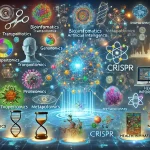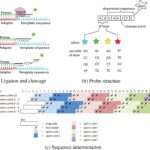
Advancements in Single-Cell Sequencing Technology in 2024
March 11, 2024Course Overview:
The course will explore the latest advancements in single-cell sequencing technology, focusing on the improvements in sample preparation methods, cost reduction, automatic cell-type identification, massively-parallel methods, combination with CRISPR-based genetic screening, development of new sequencing methods, integration with other technologies, and future directions in the field.
Course Objectives:
- Understand the principles of single-cell sequencing.
- Learn about the latest advancements in sample preparation methods for single-cell sequencing.
- Explore the reduction in cost and increased throughput of single-cell RNA sequencing.
- Gain knowledge about automatic cell-type identification using R packages.
- Learn about massively-parallel methods in single-cell sequencing.
- Understand the combination of single-cell RNA sequencing with CRISPR-based genetic screening techniques.
- Explore the development of new sequencing methods for single-cell sequencing.
- Understand the integration of single-cell sequencing with other technologies.
- Explore future directions in single-cell sequencing technology.
Introduction to Single-Cell Sequencing
Principles of single-cell sequencing
Single-cell sequencing is a powerful tool that allows researchers to analyze the genetic and molecular makeup of individual cells, providing insights into cellular heterogeneity, cell-to-cell interactions, and developmental processes. Here are some key principles of single-cell sequencing:
- Cell Isolation: Single-cell sequencing begins with the isolation of individual cells from a sample. This can be done using techniques such as fluorescence-activated cell sorting (FACS), microfluidics, or manual picking under a microscope.
- Cell Lysis and RNA Capture: Once isolated, the cell is lysed to release its genetic material, which is then captured and reverse-transcribed into complementary DNA (cDNA). This cDNA represents the transcriptome of the cell.
- Library Preparation: The cDNA is then amplified and prepared into a sequencing library. Various protocols exist for library preparation, including SMART-seq, Drop-seq, and 10x Genomics.
- Sequencing: The prepared library is then sequenced using high-throughput sequencing technologies such as Illumina sequencing. This generates millions of short sequences (reads) that represent the transcripts present in the cell.
- Data Analysis: The sequenced reads are aligned to a reference genome or transcriptome to identify the genes expressed in each cell. Bioinformatics tools are used to quantify gene expression levels, identify cell types, and analyze cellular heterogeneity.
- Cell Clustering and Visualization: Using statistical methods such as clustering algorithms, cells can be grouped based on their gene expression profiles. Visualization techniques such as t-distributed stochastic neighbor embedding (t-SNE) or uniform manifold approximation and projection (UMAP) are often used to visualize the high-dimensional data in two or three dimensions.
- Functional Analysis: Once cells are clustered, researchers can perform functional analysis to identify enriched pathways, gene regulatory networks, and other biological processes associated with specific cell types or states.
- Integration with Other Data Types: Single-cell sequencing data can be integrated with other omics data, such as bulk RNA-seq, ATAC-seq, or epigenetic data, to gain a more comprehensive understanding of cellular function and regulation.
- Applications: Single-cell sequencing has a wide range of applications in biology and medicine, including understanding development and differentiation, studying disease mechanisms, identifying biomarkers, and advancing precision medicine.
Overall, single-cell sequencing enables researchers to study the complexity of biological systems at the single-cell level, providing insights that were not possible with traditional bulk sequencing methods.
Importance of single-cell sequencing in biological research
Single-cell sequencing has revolutionized biological research by enabling the study of individual cells, which was previously not feasible with bulk sequencing methods. Here are some key reasons why single-cell sequencing is important in biological research:
- Cellular Heterogeneity: Single-cell sequencing allows researchers to uncover the heterogeneity within a population of cells. It reveals differences in gene expression, mutations, and epigenetic modifications between individual cells, providing insights into cell-to-cell variability and subpopulations within tissues.
- Developmental Biology: Single-cell sequencing provides a detailed view of gene expression dynamics during development. It can identify transcriptional changes that drive cell fate decisions, lineage commitment, and tissue patterning, helping to understand developmental processes at a molecular level.
- Disease Mechanisms: Single-cell sequencing can elucidate the molecular basis of diseases by identifying rare cell types, disease-associated cell states, and pathways that are dysregulated in diseases such as cancer, neurodegenerative disorders, and autoimmune diseases. It can also reveal the cellular response to therapies.
- Biomarker Discovery: Single-cell sequencing can identify cell-specific markers that can be used to distinguish between cell types or states. These markers can serve as diagnostic or prognostic biomarkers for diseases or as targets for therapeutic intervention.
- Immune Profiling: Single-cell sequencing enables detailed characterization of immune cell populations, including rare cell types and states. This is crucial for understanding immune responses, immunotherapy development, and autoimmune diseases.
- Stem Cell Biology: Single-cell sequencing can elucidate the molecular mechanisms underlying stem cell maintenance, differentiation, and reprogramming. It can identify novel markers for stem cell populations and monitor their behavior over time.
- Single-Cell Genomics in Microbiology: For microbial communities, single-cell genomics allows researchers to study individual microbial cells, revealing the diversity, metabolic potential, and interactions within microbial populations.
- Drug Discovery and Development: Single-cell sequencing can be used to identify drug targets, understand drug resistance mechanisms, and predict drug responses at the single-cell level, leading to more effective and personalized therapeutics.
- Biomedical Research: Single-cell sequencing is advancing our understanding of complex biological processes, such as aging, tissue regeneration, and host-pathogen interactions, by providing insights into the molecular mechanisms at play in individual cells.
Overall, single-cell sequencing is a powerful tool that is transforming our understanding of biology by revealing the complexity and diversity of cellular systems, providing new insights into health and disease, and paving the way for personalized medicine.
Improved Sample Preparation Methods
Advancements in sample preparation methods
Sample preparation is a critical step in single-cell sequencing, impacting the quality and reliability of the data obtained. Advancements in sample preparation methods have significantly improved the efficiency, sensitivity, and throughput of single-cell sequencing. Here are some key advancements:
- Microfluidics: Microfluidic devices allow for the manipulation and analysis of individual cells in microscopic channels. These devices enable high-throughput single-cell isolation, lysis, and library preparation, reducing sample loss and contamination.
- Cell Sorting: Fluorescence-activated cell sorting (FACS) and magnetic-activated cell sorting (MACS) have been optimized for single-cell isolation, allowing researchers to isolate specific cell types based on surface markers or other characteristics.
- Single-Cell Lysis: Gentle and efficient methods for lysing single cells have been developed to preserve RNA integrity and minimize bias. Techniques such as laser capture microdissection (LCM), chemical lysis, and thermal lysis are used to lyse individual cells.
- RNA Capture and Amplification: Methods for capturing and amplifying RNA from single cells, such as SMART-seq, Drop-seq, and CEL-seq, have been optimized to minimize amplification bias and improve transcript coverage.
- Library Preparation: Various commercial kits and protocols for single-cell library preparation have been developed, offering improved sensitivity, reproducibility, and compatibility with different sequencing platforms.
- Multiplexing: Multiplexing strategies allow for the simultaneous sequencing of multiple single cells, increasing throughput and reducing cost per cell. Barcoding techniques, such as Unique Molecular Identifiers (UMIs) and cell hashing, enable the pooling of cells for parallel sequencing.
- Quality Control: Advances in quality control methods, such as RNA spike-ins and molecular barcoding, help assess the quality and quantify the technical noise in single-cell sequencing data.
- Integration with Imaging: Integration of single-cell sequencing with imaging techniques, such as in situ sequencing and spatial transcriptomics, allows for the spatial mapping of gene expression within tissues and organs.
These advancements have greatly expanded the scope and applications of single-cell sequencing, enabling researchers to study complex biological processes at the single-cell level with unprecedented detail and resolution.
Enhanced data resolution and quality
Enhanced data resolution and quality in single-cell sequencing are critical for accurately characterizing cellular heterogeneity, identifying rare cell populations, and understanding complex biological processes. Several advancements have contributed to improving data resolution and quality:
- Reduced Cell Doublets: Doublets, which occur when two cells are inadvertently sequenced together, can lead to misinterpretation of data. Advances in cell isolation techniques, such as microfluidics and FACS, help reduce the incidence of doublets, improving the purity of single-cell sequencing data.
- Improved Transcript Coverage: Enhanced library preparation methods, such as SMART-seq and other full-length RNA-seq protocols, provide more comprehensive coverage of transcripts in single cells, capturing rare and lowly expressed genes more effectively.
- Unique Molecular Identifiers (UMIs): UMIs are short random sequences added to individual RNA molecules during library preparation. They enable the removal of PCR duplicates and improve the accuracy of quantification by distinguishing between identical RNA molecules originating from different cells.
- Cell Barcoding: Cell barcoding allows for the multiplexing of single cells during library preparation, enabling the pooling of cells for parallel sequencing. This reduces technical variability and improves the efficiency of sequencing reactions.
- Computational Methods for Data Analysis: Advanced bioinformatics tools and algorithms have been developed to process and analyze single-cell sequencing data, including methods for cell clustering, dimensionality reduction, and differential gene expression analysis. These tools help extract meaningful biological insights from complex datasets.
- Integration with Other Omics Data: Integration of single-cell sequencing data with other omics data, such as epigenomic and proteomic data, provides a more comprehensive view of cellular function and regulation, enhancing the resolution and interpretability of the data.
- Quality Control Metrics: Various quality control metrics, such as the percentage of mitochondrial reads, gene detection rate, and library complexity, are used to assess the quality of single-cell sequencing data and identify potential sources of noise or bias.
These advancements collectively contribute to improving the resolution, accuracy, and interpretability of single-cell sequencing data, allowing researchers to unravel the complexities of cellular heterogeneity and gene regulation with unprecedented detail.
Cost Reduction and Increased Throughput
Decrease in cost per cell
The cost per cell in single-cell sequencing has decreased significantly over the years, primarily due to technological advancements and increased efficiency in sample preparation and sequencing methods. Several factors have contributed to this decrease:
- Increased Throughput: High-throughput sequencing technologies, such as Illumina sequencing platforms, can now process a larger number of cells in parallel, reducing the cost per cell.
- Improved Library Preparation Efficiency: Advances in library preparation protocols have increased the efficiency of capturing and amplifying RNA from single cells, allowing researchers to obtain more sequencing data from each cell and reducing the cost per cell.
- Barcoding Strategies: Barcoding strategies, such as Unique Molecular Identifiers (UMIs) and cell hashing, enable the pooling of cells for parallel sequencing, reducing the number of sequencing reactions required and lowering the cost per cell.
- Automation: Automation of sample preparation and sequencing processes has increased throughput and reduced labor costs, contributing to a decrease in the overall cost per cell.
- Competition and Economies of Scale: Increased competition among sequencing service providers and the growing adoption of single-cell sequencing in research have led to economies of scale, driving down the cost per cell.
- Improved Data Analysis Tools: Advanced bioinformatics tools and algorithms have made data analysis more efficient and cost-effective, reducing the overall cost of single-cell sequencing experiments.
Overall, the decreasing cost per cell in single-cell sequencing has made this technology more accessible to researchers, enabling a wider range of studies and accelerating discoveries in biology and medicine.
Technological advancements leading to reduced overall cost
Technological advancements have played a significant role in reducing the overall cost of single-cell sequencing experiments. Here are some key advancements that have contributed to this reduction:
- Improved Sequencing Platforms: Next-generation sequencing (NGS) platforms have become more cost-effective, with increased sequencing depth and throughput. This allows researchers to sequence more cells in a single run, reducing the cost per cell.
- Multiplexing Strategies: Barcoding and indexing strategies, such as Unique Molecular Identifiers (UMIs) and cell hashing, enable the simultaneous sequencing of multiple cells in a single reaction. This reduces the number of sequencing runs required and lowers the overall cost.
- Automation: Automation of sample preparation, library construction, and sequencing processes has increased throughput and reduced labor costs, contributing to a decrease in the overall cost of single-cell sequencing.
- Reduced Reagent Costs: Advances in reagent formulation and manufacturing have led to lower costs for enzymes, primers, and other consumables used in single-cell sequencing workflows.
- Improved Library Preparation Protocols: Streamlined and more efficient library preparation protocols have reduced the amount of input material required and minimized reagent waste, leading to cost savings.
- Open-Source Software and Analysis Tools: The availability of open-source bioinformatics software and analysis tools has reduced the cost of data analysis, making it more accessible to researchers with limited resources.
- Standardization and Optimization: Standardized protocols and optimized workflows have increased the reproducibility of single-cell sequencing experiments, reducing the need for costly troubleshooting and optimization steps.
- Economies of Scale: As single-cell sequencing becomes more widely adopted, sequencing service providers are able to offer lower prices due to economies of scale, further reducing the overall cost of experiments.
Overall, these technological advancements have made single-cell sequencing more cost-effective, enabling researchers to perform larger and more complex experiments at a lower cost and accelerating discoveries in the field of genomics.

















